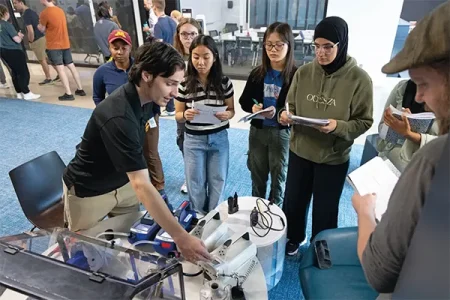
PFAS (per- and polyfluoroalkyl substances) are some of the world’s most persistent chemicals. Developed in the 1940s, the then-called PFCs were perfect for a variety of industrial and consumer products, including non-stick cookware, stain repellents for furniture (Scotchguard), and a specialized foam to fight petroleum fires, called aqueous film-forming foam (AFFF), used across the world and principally at airports and military bases.
In the late 1990s, studies began to show that PFAS were everywhere in the environment, including in water, soil, wildlife, and our own bodies. They have been linked to cancer and immune dysfunction, as well as categorized as “obesogens” that can interfere with human weight regulation. The tricky question is what to do with PFAS, especially as they migrate into our water systems and disperse into the environment. Until recently, no one had discovered an effective and inexpensive way to do that.
In 2011, the Department of Defense issued a challenge: It wanted to remediate PFAS-contaminated groundwater near military bases in the U.S. and around the world that had used AFFF. The DoD called for proposals that presented potential solutions.
School of Public Health associate professor Matt Simcik knew that when PFAS enter groundwater, they become part of a plume that flows toward a water source, like the Mississippi River. Simcik hypothesized that if you could introduce a coagulant — perhaps a non-toxic compound used every day in drinking water treatment — into that plume to help the PFAS adhere to larger particles, you could then create a barrier that would contain the PFAS, but let clean water flow through.
Simcik put his theory to the test in the lab, using soil from an Air Force base and flowing simulated contaminated groundwater through the soil with and without the coagulants.
“The idea is to keep PFAS from moving off military bases and into water sources, while other people are figuring out ways to destroy them underground,” says Simcik. While this method has only been tested in the laboratory, Simcik hopes to test it in a real-life situation in the future.
The Model
A commercially available non-toxic coagulant combines with PFAS molecules and the mixture then sticks to soil particles. A barrier forms that allows water to flow through, but contains the PFAS. Simcik sees two ways to implement the method in the field. One is to drill a series of wells into an area where PFAS have penetrated into the groundwater and inject the coagulant to form a permeable absorptive barrier. The other method is to inject the coagulant into the ground through an existing drinking water well, creating a barrier around the well through which clean water can be drawn.
The Impact
Simcik believes that his method can be used to sequester PFAS before they reach water in systems like lakes, streams, rivers, and wastewater treatment plants around the globe, protecting public health and the natural world. By treating the contaminated water prior to using it for drinking water, we not only protect people, but also the ecosystems that depend on clean water.


